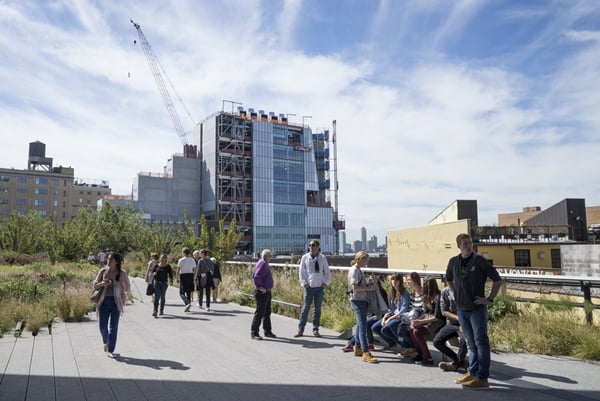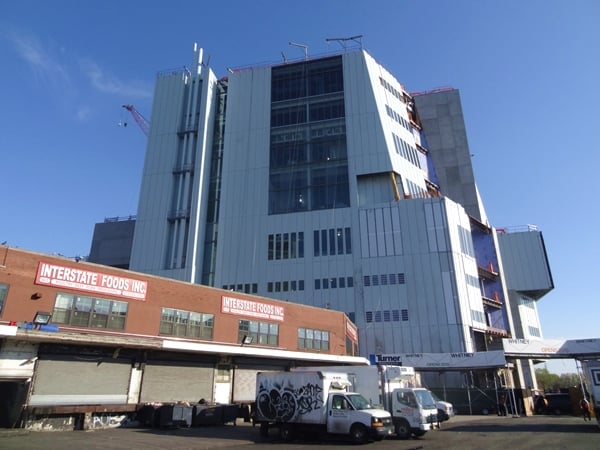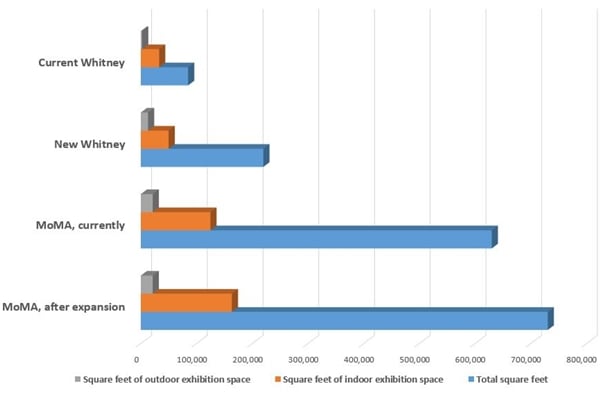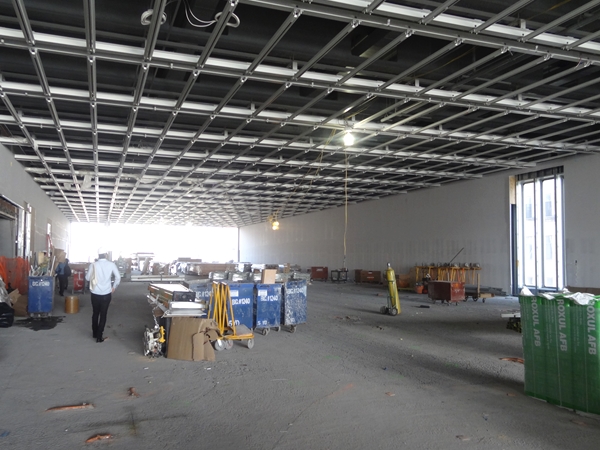Art World
New Whitney Ready to Take on MoMA
Giant galleries and an unbeatable location will put the Modern on the ropes.

Giant galleries and an unbeatable location will put the Modern on the ropes.

Benjamin Sutton


The exterior of the new Whitney Museum building.
Photo: Benjamin Sutton.
Is the Whitney set to supplant MoMA as New York’s go-to modern art museum? The institution will begin moving into its new Renzo Piano building later this year, with the Meatpacking District location opening to the public about one year from now. It’s hard to say how exactly the new building and location will change the dynamic among New York’s top tier of art museums, but a look at the numbers makes it clear that the Whitney’s move is literally and symbolically huge, and will put it in more direct competition with the Museum of Modern Art.
The Whitney’s Marcel Breuer building on Madison Avenue is much smaller than most people realize. At just 85,000 square feet, it is markedly smaller, for instance, than the new 100,000-square-foot Hauser Wirth & Schimmel gallery in Los Angeles—which, to be fair, is an exceptionally huge gallery. It has a mere 33,000 square feet of exhibition space spread over its five stories, with an additional 2,400 square feet in its sunken sculpture court. The Whitney’s best year ever for attendance was 2009–10, when it had 372,000 visitors. To compare that to other museums in the Whitney’s current weight class, the nearby (and much smaller) Frick Collection had 420,000 visitors in 2013; Washington DC’s Hirshhorn Museum and Sculpture Garden—which is bigger, but located in Washington, DC—had 645,000 visitors last year. The Whitney’s brand and reputation—the institution’s place in people’s minds, fueled in part by its still-seminal biennial—seem to be more popular than the actual museum. But that’s about to change.

The Whitney Museum’s current Marcel Breuer building on Madison Avenue.
Photo: Gryffindor, via Wikimedia Commons.
The downtown Whitney is gargantuan. Its 50,000 square feet of indoor exhibition space, the bulk of it spread across its vast upper levels, represents an increase of 33 percent from the current galleries. The building as a whole is 220,000 square feet, nearly a three-fold increase from the Breuer building, providing numerous back-of-house facilities that the outdated uptown building lacks. The biggest space in Piano’s building, the 18,200-square-foot fifth-floor gallery, feels as long and wide as an interstate. That gallery alone has more than half the current Whitney’s exhibition space. It dwarfs anything at MoMA, and is destined to become New York’s equivalent of Tate’s Turbine Hall. Now major traveling exhibitions and large-scale installations that might otherwise have ended up in MoMA’s atrium will have an even more attractive New York venue to consider. Factor in 13,000 square feet of outdoor and terrace spaces—a five-fold increase over the cramped sculpture court on Madison Avenue—a 6,000-square-foot lobby, and an outdoor plaza of over 8,000 square feet that will host large-scale sculptures and installations, and the spaces where art will be exhibited in the new Whitney add up to over 75,000 square feet.

Chart comparing the dimensions of the current and future Whitney Museum and MoMA buildings.
Chart by artnet News.
That’s about half of MoMA’s current exhibition spaces, which include 125,000 square feet of galleries and its 21,400-square-foot sculpture garden. (MoMA’s own expansion, set for completion in 2018 or 2019, will add nearly 40,000 square feet of indoor exhibition spaces.) But what makes the Whitney’s move so major is that it achieves that oh-so-rare combination of New York real estate coups: more space, and a better location.
The Whitney is moving out of a museum-saturated neighborhood and into the tourist-beloved Meatpacking District, right alongside the city’s hippest park, all of which is sure to bring in MoMA-like attendance numbers. In 2009–10, the year the Whitney set its all-time attendance record of 372,000 visitors, MoMA welcomed 3.22 million people, also an institutional record. That might seem like a big gap to close, but consider that the Whitney’s closest neighbor, the elevated park the High Line, will be bringing its droves of visitors—4.4 million in 2012, up from 3.7 million in 2011—right to the museum’s front door. That’s a hell of a visitor-delivery system.

The fifth floor gallery in the new Whitney Museum building.
Photo: Benjamin Sutton.
It may never be bigger or more popular than MoMA, just as Edward Hopper will never be better known than Pablo Picasso, but the Whitney is poised to move up a couple weight classes and assert itself as New York City’s third art museum.